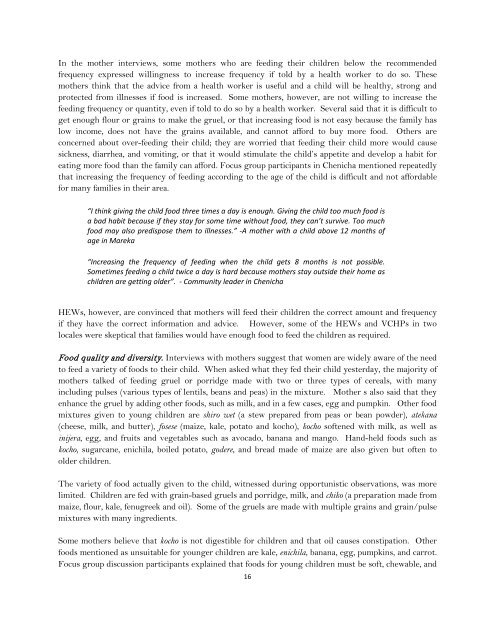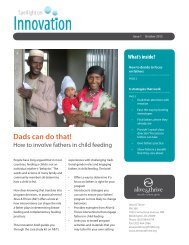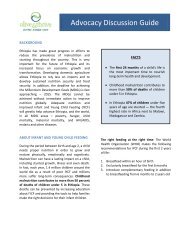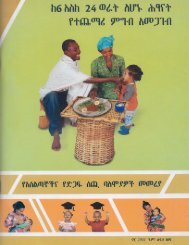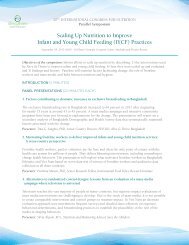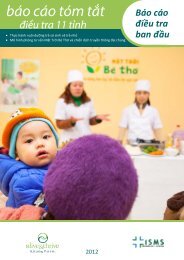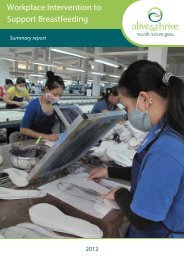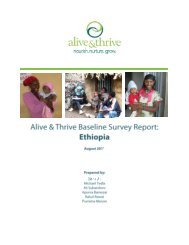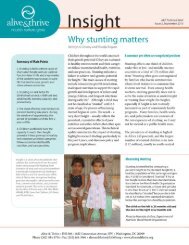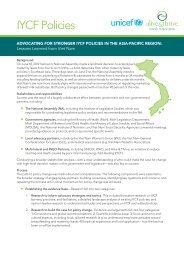IYCF Practices, Beliefs, and Influences in SNNP ... - Alive & Thrive
IYCF Practices, Beliefs, and Influences in SNNP ... - Alive & Thrive
IYCF Practices, Beliefs, and Influences in SNNP ... - Alive & Thrive
You also want an ePaper? Increase the reach of your titles
YUMPU automatically turns print PDFs into web optimized ePapers that Google loves.
In the mother <strong>in</strong>terviews, some mothers who are feed<strong>in</strong>g their children below the recommendedfrequency expressed will<strong>in</strong>gness to <strong>in</strong>crease frequency if told by a health worker to do so. Thesemothers th<strong>in</strong>k that the advice from a health worker is useful <strong>and</strong> a child will be healthy, strong <strong>and</strong>protected from illnesses if food is <strong>in</strong>creased. Some mothers, however, are not will<strong>in</strong>g to <strong>in</strong>crease thefeed<strong>in</strong>g frequency or quantity, even if told to do so by a health worker. Several said that it is difficult toget enough flour or gra<strong>in</strong>s to make the gruel, or that <strong>in</strong>creas<strong>in</strong>g food is not easy because the family haslow <strong>in</strong>come, does not have the gra<strong>in</strong>s available, <strong>and</strong> cannot afford to buy more food. Others areconcerned about over-feed<strong>in</strong>g their child; they are worried that feed<strong>in</strong>g their child more would causesickness, diarrhea, <strong>and</strong> vomit<strong>in</strong>g, or that it would stimulate the child’s appetite <strong>and</strong> develop a habit foreat<strong>in</strong>g more food than the family can afford. Focus group participants <strong>in</strong> Chenicha mentioned repeatedlythat <strong>in</strong>creas<strong>in</strong>g the frequency of feed<strong>in</strong>g accord<strong>in</strong>g to the age of the child is difficult <strong>and</strong> not affordablefor many families <strong>in</strong> their area.“I th<strong>in</strong>k giv<strong>in</strong>g the child food three times a day is enough. Giv<strong>in</strong>g the child too much food isa bad habit because if they stay for some time without food, they can’t survive. Too muchfood may also predispose them to illnesses.” -A mother with a child above 12 months ofage <strong>in</strong> Mareka“Increas<strong>in</strong>g the frequency of feed<strong>in</strong>g when the child gets 8 months is not possible.Sometimes feed<strong>in</strong>g a child twice a day is hard because mothers stay outside their home aschildren are gett<strong>in</strong>g older”. - Community leader <strong>in</strong> ChenichaHEWs, however, are conv<strong>in</strong>ced that mothers will feed their children the correct amount <strong>and</strong> frequencyif they have the correct <strong>in</strong>formation <strong>and</strong> advice. However, some of the HEWs <strong>and</strong> VCHPs <strong>in</strong> twolocales were skeptical that families would have enough food to feed the children as required.Food quality <strong>and</strong> diversity. Interviews with mothers suggest that women are widely aware of the needto feed a variety of foods to their child. When asked what they fed their child yesterday, the majority ofmothers talked of feed<strong>in</strong>g gruel or porridge made with two or three types of cereals, with many<strong>in</strong>clud<strong>in</strong>g pulses (various types of lentils, beans <strong>and</strong> peas) <strong>in</strong> the mixture. Mother s also said that theyenhance the gruel by add<strong>in</strong>g other foods, such as milk, <strong>and</strong> <strong>in</strong> a few cases, egg <strong>and</strong> pumpk<strong>in</strong>. Other foodmixtures given to young children are shiro wet (a stew prepared from peas or bean powder), atekana(cheese, milk, <strong>and</strong> butter), fosese (maize, kale, potato <strong>and</strong> kocho), kocho softened with milk, as well as<strong>in</strong>ijera, egg, <strong>and</strong> fruits <strong>and</strong> vegetables such as avocado, banana <strong>and</strong> mango. H<strong>and</strong>-held foods such askocho, sugarcane, enichila, boiled potato, godere, <strong>and</strong> bread made of maize are also given but often toolder children.The variety of food actually given to the child, witnessed dur<strong>in</strong>g opportunistic observations, was morelimited. Children are fed with gra<strong>in</strong>-based gruels <strong>and</strong> porridge, milk, <strong>and</strong> chiko (a preparation made frommaize, flour, kale, fenugreek <strong>and</strong> oil). Some of the gruels are made with multiple gra<strong>in</strong>s <strong>and</strong> gra<strong>in</strong>/pulsemixtures with many <strong>in</strong>gredients.Some mothers believe that kocho is not digestible for children <strong>and</strong> that oil causes constipation. Otherfoods mentioned as unsuitable for younger children are kale, enichila, banana, egg, pumpk<strong>in</strong>s, <strong>and</strong> carrot.Focus group discussion participants expla<strong>in</strong>ed that foods for young children must be soft, chewable, <strong>and</strong>16


